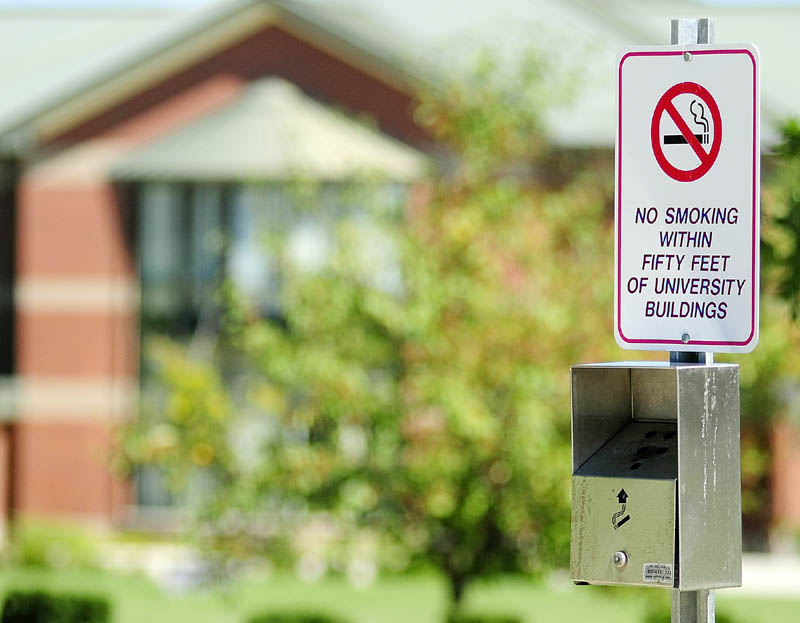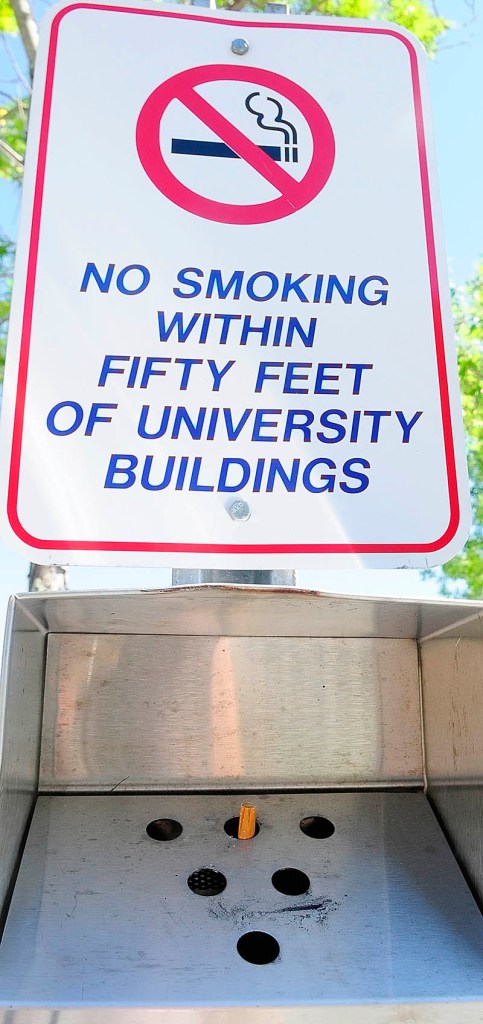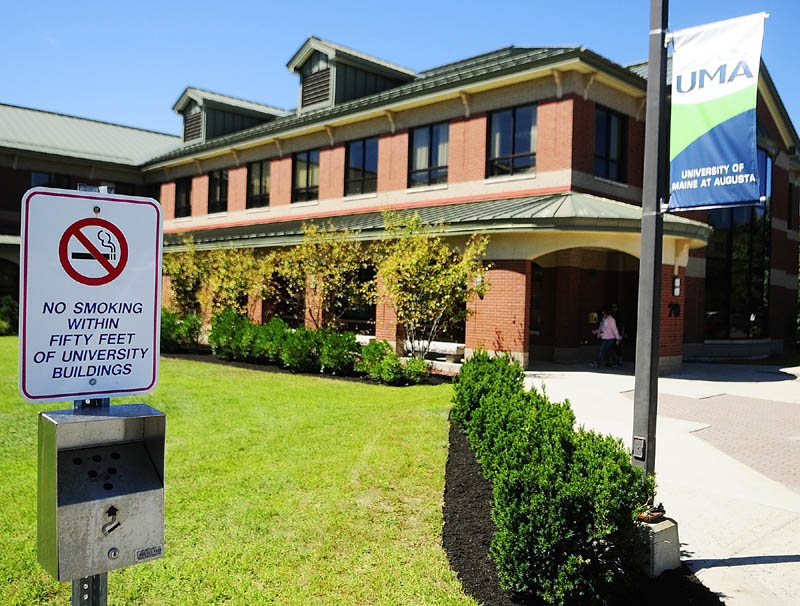AUGUSTA — The University of Maine at Augusta will ban tobacco use starting in January, joining a growing number of colleges and universities in Maine and around the country.
The policy will “promote a campus culture of wellness and environmental responsibility,” President Allyson Handley wrote in an email to faculty, staff and students this week.
UMA officials started talking about going tobacco-free more than a month ago, and they watched the University of Maine, the University of Maine at Farmington, Kennebec Valley Community College in Fairfield and the city of Augusta enact similar policies in the past two years.
“I think it was just a matter of time that we decided that it was time for us, too,” said Leslie Ellis, a human resources employee and chairwoman of the university’s wellness committee.
Now, smoking is prohibited within 50 feet of building entrances at UMA.
Officials plan more outreach and education this fall before the ban starts Jan 1., and penalties do not take effect until July 1.
The University of Southern Maine also will be tobacco-free on Jan. 1, and Colby College in Waterville will start limiting tobacco use this fall and has a goal of a ban for next fall.
The American Nonsmokers’ Rights Foundation counts at least 774 smoke-free campuses in the U.S., of which 562 are tobacco-free. Three states — Arkansas, Oklahoma and Iowa — require public college campuses to be smoke-free.
UMA’s new policy prohibits anyone on the university’s campuses in Augusta and Bangor, or at the nine University College centers, from using any tobacco products or non-FDA approved nicotine products such as electronic cigarettes.
There is one exception to the rule: people may use tobacco inside their vehicles with the windows rolled up, as long as they dispose of cigarette butts inside the vehicle.
John Tiner, grilling with University College colleagues on the mostly-empty UMA campus on Wednesday, welcomed news about the tobacco-free policy. Many smokers don’t follow UMA’s policy of staying 50 feet from building entrances, he said.
“Everyone’s right here,” Tiner said, gesturing to the door of the Katz Library. “You come through this door, and you’re going through the cloud all the time.”
Rich Frino, another University College employee, said he usually ends up smoking next to the trash receptacle behind the library building. Starting in January, he’ll have to go to his car, but he said that smells like cigarettes already.
“I think it’s a smart change for the campus,” Frino said. “Their arguments are right about secondhand smoke and general cleanliness.”
UMA employees who use tobacco on campus will be subject to the same progressive discipline process that applies for violations of other policies.
Students will receive two warnings, and a third violation will trigger a formal student conduct procedure. Penalties start at a $25 fine or two hours of community service and escalate to possible suspension.
The university will promote tobacco cessation resources and train employees to refer tobacco users who want to quit, college officials said.
“I truly understand that our new policy may pose a hardship for some of you,” Handley wrote in an email to students and staff. “However, we need to weigh those hardships against the very significant health issues involved, and the simple truth is that secondhand smoke is a class A carcinogen, the most toxic class of chemicals known to cause cancer.”
University spokesman Bob Stein said that in meetings on both campuses last spring, most people were supportive of the tobacco ban, but there were people who opposed it, including tobacco users and some instructors concerned about their students.
“I think there was some concern that people who couldn’t go three hours without smoking would have a tough time with this policy,” Stein said.
Some UMA classes run almost three hours, with a break in the middle. That’s part of the rationale for allowing smoking in personal vehicles, Stein said.
UMA’s Student Government Association conducted an informal survey on the issue last spring. With about 400 students responding, 59 percent said they were in favor of a tobacco-free campus, 26 percent opposed and 15 percent with no strong opinion.
The University of Maine became the first school in the state to ban the use of tobacco on its Orono campus, starting Jan. 1, 2011. Penalties went into effect this past January, but Student Wellness Resource Center Director Lauri Sidelko said fewer than 10 students have been reported to the student conduct process for violations.
Since the ban went into effect, University of Maine staff learned the importance of communication, training people to provide tobacco cessation resources and recognizing the challenge the ban posed for many people, Sidelko said.
“It’s truly an addiction,” she said. “It’s not about hating the smoker. It’s not personal. It’s not about, ‘You can’t do that.’ It’s that you can’t do that here.”
According to Gallup, 20 percent of Mainers smoke, just under the national average of 21 percent. UMA’s smoking rate, however, may be higher because the university serves students from groups more likely to smoke, such as military veterans and people making life transitions.
“If somebody has lost their job and is re-entering school, they might be more likely to use tobacco,” said Joanne Joy, executive director of Healthy Communities of the Capital Area. Joy’s agency is funded by tobacco settlement money and has helped UMA access tobacco cessation training and resources.
Joy said she is happy to see UMA and other institutions going tobacco-free.
“From my perspective, the whole opportunity for folks to be in a smoke-free environment is just amazing,” she said. “The health benefits of being someplace that’s smoke-free really are beyond description.”
Send questions/comments to the editors.





